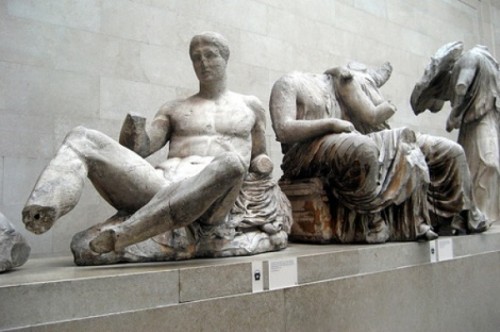All the Marbles
American Indian artifacts must not fall into the hands of profiteers.
By John Saltas @johnsaltasAnyone who has previously read this column
knows I’m quite proud of being Greek.
They also know I’m not a full-blooded
Greek, and that a fourth of my genes link
me to the first Mormon pioneers to settle
Utah via my great-great grandfather
Matthew Caldwell, who was a member
of the Mormon Battalion. As I’ve written
before, he passed along a “good sense”
gene, and one of his granddaughters, my
grandmother, married a Greek immigrant.
Actually, the genetic good sense to marry
outside the flock may have come from
Caldwell’s fifth wife, Nancy Lane. Either
way, it worked out for me.
My grandmother never became Greek
Orthodox, and my grandfather never
became a Mormon. When the local Relief
Society women would come by to visit my
grandmother, my grandfather would simply
withdraw to the kitchen and have a glass of
wine. When my grandfather’s Greek friends
would drop by, my grandmother would
say something like, “I wish they’d speak
English!” and go back to her crochet work.
They stayed happily married for 63 years.
They lived in the house right behind us
in Bingham Canyon. I used to love hearing
their stories, she born in a log cabin (still
standing) in Dry Fork, Utah, above Vernal;
he, leaving his family behind in Crete at
17 and, after a month of travel, starting
work in a Sunnyside coal mine his first day
in Utah. She told me about her American
Indian neighbors (in the impolite but
accepted vernacular of the day, btw) and
of growing up with few “white” neighbors.
He told me about the Turkish “barbarians”
who occupied his beloved Crete, and
how his own father was a guerrilla fighter
against them. She told me pioneer stories.
He told me about Zeus and Minos.
Thanks to my grandmother, I developed
a keen desire to learn about the West, and
came to understand that, in her mind,
the West began when her family arrived.
Through my grandfather, I developed the
understanding that Utah didn’t begin in
1847, and the Earth was more than 4,000
years old to boot. He spoke with pride about
the ancient wonders of Greece—nearly none
of which he ever saw—and in reverence
about the cultural Greek legacies of democracy,
medicine and philosophy. She spoke
with equal pride and reverence about the
travails of her own pioneer heritage.
So it is that I can fairly guess where
they would land on the topic of digging
of American Indian
artifacts in southern
Utah. In my grandmother’s
world, the
residents of Blanding
were rightful settlers
of the land, heirs
to anything that
land provided. They
developed the town,
brought commerce to
the area and would be
friendly to the natives there as long as the
natives were friendly first. In her world, collecting
artifacts would be a gainful hobby
if not also a way to find additional income.
She would, however, draw the line at grave
desecration—she was a sentimentalist of
the first order in that regard.
My grandfather, while no more simpatico
with the American Indian culture than
with the Mormon one, would nonetheless
question the good of digging up any artifacts
at all. As a witness to his own culture
being robbed of not only its own relics but
even of its cultural heroes, he would not
want to see another culture plundered.
The Crete he was born to in 1887 was under
Turkish occupation. The Utah he moved
to in 1906 revealed to him an occupation
of another type and, in an uneasy way,
caused him to consider if the shoe was on
the other foot. If there was just one thing
he respected most, it was honesty. An honest
Indian was as good to him as an honest
Greek—probably better, actually. If he
knew that the American Indian were honestly
aggrieved, he would be on that side.
And that’s the side I’m on. My grandfather would know what it feels like to have a piece of heritage taken away. While the flamers on local newspaper Websites are all wound up about the events that recently played out in Blanding, all pointing fingers, calling names and doing nothing, a very similar story is playing out on the world stage. In 1817, the Parthenon Marbles—2,500-year-old statues, plus a frieze that once adorned the Acropolis in Athens—were sold to the British Museum by Lord Elgin. He bought them from the Ottoman Turks who occupied Athens at that time for nearly nothing. His motive was to profit. He got his money and fame, too, for now the Parthenon Marbles are in the British Museum and are called the Elgin Marbles.
England thinks they
are better stewards of
those marbles than the
Greeks. Many Utahns
think they are better land stewards than
native Utahns. Must be a British Isle thing.
England claims the marbles belong to the
world. Greece begs to differ. England says
there is no place to properly display the marbles
in Athens. That is not true. This past
weekend, the new Acropolis Museum was
opened to the public. Besides quickly gaining
a spot as a world-class museum inside and
out, a primary function of the new museum
is to draw world attention to the Parthenon
Marbles and for those marbles to be returned
to the place Zeus intended.
There’s no Greek who cannot support the return of the Parthenon Marbles to Greece. Equally, there is no reason a Greek cannot support full protection of American Indian lands and of everything that resides on them. American Indian artifacts must not fall into the hands of profiteers; Greek artifacts must be taken from them. Mitts off American Indian property. Return the stolen Parthenon Marbles to Greece.
Speaking of...
-
Monumental Order
Challenging the Antiquities Act of 1906, Trump promises 'tremendously positive things'
- Apr 26, 2017
-
Monday Meal: Pie & Beer Pairings
- Jul 25, 2016
-
Wine (and Gin!) Wednesday: Beehive @ Bandits
- Jun 22, 2016
- More »
More by John Saltas
-
Instead of a Statue of Responsibility, Utah could build a statue of shame depicting Mike Lee.
Private Eye
- Apr 17, 2024
-
Utah's Statue of Responsibility invites high-brow thinking, and a few low-brow jokes.
Private Eye
- Apr 10, 2024
-
John Stockton's entitled to his privacy and his COVID opinions, but not false facts.
Private Eye
- Mar 27, 2024
- More »






